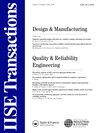混合交叉对接供应链中的最优运输、协作和外包决策
IF 2
3区 工程技术
Q3 ENGINEERING, INDUSTRIAL
引用次数: 0
摘要
摘要在油田服务行业合作伙伴供应链的激励下,我们研究了一个分散的、由供应商、混合交叉码头设施和油井设施组成的三级供应链中的运输、协作和外包决策。与将货物快速转运到下游的纯交叉对接不同,混合交叉对接允许库存在交叉码头停留多个时期。建立了混合交叉对接供应链中各成员成本最小的多周期优化模型,并建立了最优解的结构性质。我们利用这些结果来确定混合交叉对接比纯交叉对接更具成本效益的条件。我们的研究结果为管理人员提供了关于何时启用混合交叉码头以及由此节省成本的价值的见解。我们还量化了供应链中不同阶段之间合作的价值。根据产品数量和持有成本的不同,上游合作可为交叉码头节省1%至9%的平均成本,而下游合作可为油井设施节省4%至13%的平均成本。我们还开发了物流公司和油井设施之间的Stackelberg定价游戏,寻求通过外包运输和库存操作来降低成本。我们确定了油井设施对外包服务价格的最佳响应结构,以及物流供应商的最优定价政策结构。我们的发现和模型,基于当前的文献,提供了以应用程序为中心的工具,允许管理人员改进供应链中的交叉对接操作,实现合作的好处,并做出更好的外包决策。关键词:交叉对接外包油田服务动态批数免责声明作为对作者和研究人员的服务,我们提供此版本的已接受稿件(AM)。在最终出版版本记录(VoR)之前,将对该手稿进行编辑、排版和审查。在制作和印前,可能会发现可能影响内容的错误,所有适用于期刊的法律免责声明也与这些版本有关。数据可用性声明由于本研究的性质,本研究的参与者不同意公开分享他们的数据,因此无法获得支持数据。本文章由计算机程序翻译,如有差异,请以英文原文为准。
Optimal Shipping, Collaboration, and Outsourcing Decisions in a Hybrid Cross-docking Supply Chain
AbstractMotivated by the supply chain of our oil-field service industry partner, we study shipping, collaboration, and outsourcing decisions in a decentralized, three-stage supply chain consisting of suppliers, a hybrid cross-dock facility, and oil well facilities. Unlike pure cross-docking, which transships arriving products quickly downstream, hybrid cross-docking allows for inventory to remain at the cross-dock for multiple periods. We formulate multi-period, optimization models to minimize costs of different members in a hybrid cross-docking supply chain and establish structural properties of optimal solutions. We make use of those results to identify conditions under which hybrid cross-docking is more cost efficient than pure cross-docking. Our results provide managerial insights regarding when a hybrid cross-dock should be enabled, and the value of the resulting cost savings. We also quantify the value of collaboration among different stages in the supply chain. Upstream collaboration results in 1% to 9% average cost savings for the cross-dock, while downstream collaboration generates 4% to 13% in average cost savings for oil well facilities, depending on the number of products and their holding cost. We also develop a Stackelberg pricing game between a logistics company and oil well facilities seeking to lower their costs by outsourcing their transportation and inventory operations. We identify the structure of oil well facilities’ best response to the price of outsourcing services, as well as the structure of the logistics provider’s optimal pricing policy. Our findings and models, based on current literature, provide application focused tools that allow managers to improve cross-docking operations in their supply chains, realize the benefits of collaborations, and make better outsourcing decisions.Keywords: Cross-dockingOutsourcingOil-field serviceDynamic lot sizingDisclaimerAs a service to authors and researchers we are providing this version of an accepted manuscript (AM). Copyediting, typesetting, and review of the resulting proofs will be undertaken on this manuscript before final publication of the Version of Record (VoR). During production and pre-press, errors may be discovered which could affect the content, and all legal disclaimers that apply to the journal relate to these versions also. Data Availability StatementDue to the nature of this research, participants of this study did not agree for their data to be shared publicly, so supporting data is not available.
求助全文
通过发布文献求助,成功后即可免费获取论文全文。
去求助
来源期刊

IISE Transactions
Engineering-Industrial and Manufacturing Engineering
CiteScore
5.70
自引率
7.70%
发文量
93
期刊介绍:
IISE Transactions is currently abstracted/indexed in the following services: CSA/ASCE Civil Engineering Abstracts; CSA-Computer & Information Systems Abstracts; CSA-Corrosion Abstracts; CSA-Electronics & Communications Abstracts; CSA-Engineered Materials Abstracts; CSA-Materials Research Database with METADEX; CSA-Mechanical & Transportation Engineering Abstracts; CSA-Solid State & Superconductivity Abstracts; INSPEC Information Services and Science Citation Index.
Institute of Industrial and Systems Engineers and our publisher Taylor & Francis make every effort to ensure the accuracy of all the information (the "Content") contained in our publications. However, Institute of Industrial and Systems Engineers and our publisher Taylor & Francis, our agents, and our licensors make no representations or warranties whatsoever as to the accuracy, completeness, or suitability for any purpose of the Content. Any opinions and views expressed in this publication are the opinions and views of the authors, and are not the views of or endorsed by Institute of Industrial and Systems Engineers and our publisher Taylor & Francis. The accuracy of the Content should not be relied upon and should be independently verified with primary sources of information. Institute of Industrial and Systems Engineers and our publisher Taylor & Francis shall not be liable for any losses, actions, claims, proceedings, demands, costs, expenses, damages, and other liabilities whatsoever or howsoever caused arising directly or indirectly in connection with, in relation to, or arising out of the use of the Content. Terms & Conditions of access and use can be found at http://www.tandfonline.com/page/terms-and-conditions .
 求助内容:
求助内容: 应助结果提醒方式:
应助结果提醒方式:


